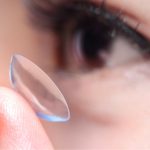Some optometrists don’t do eye checks before selling contact lenses
This post first appeared on Channel News Asia on 14 Oct 2018
Buying contact lenses at retail stores with optometry services may not be as safe it seems. This Channel NewsAsia reporter found out that some licensed optometrists do not conduct proper eye examinations before prescribing contact lenses.
SINGAPORE: For Ms Jasmine Chee, getting her monthly supply of contact lenses used to be a straightforward affair. She would pop into an optical shop, provide the optometrist with details about her myopia, pay for the lenses and pop out.
That was her routine over the last 10 years or so since she started wearing contact lenses, until she found out she had corneal neovascularization – an eye condition that could result in blindness.
The condition is caused by a lack of oxygen to the cornea, which can come from wearing ill-fitting contact lenses. Ms Chee believes this could have been avoided had her optometrists done their due diligence before selling her the lenses.
“When you buy contact lenses in Singapore, they will ask what’s your degree and then you just buy from them off the shelf. They don’t ask you to try it on to see whether the contact lenses are suitable for you,” she said.
She claimed that the only time she had her eyes examined by her optometrists was when she first tried wearing contact lenses.
EYE EXAM, FITTING NOT COMMONLY PRACTISED
While the Optometrists and Opticians Board’s (OOB) code of professional conduct requires licensed optometrists to assess a patient’s suitability for contact lenses, Channel NewsAsia has found that some practitioners do not strictly adhere to this.
When this reporter visited four optical stores to buy contact lenses, only one insisted on conducting an eye examination first before selling.
The other three did not perform any eye checks. After telling the shops’ staff my lens’ power, I bought five months’ supply of disposable coloured contact lenses, which cost more than S$130.
I then took the lenses to Ngee Ann Polytechnic’s Optometry Centre. This is where optometrists would check on a patient’s vision, eye pressure, as well as the front and back of the eyes to determine whether they are suitable for contact lenses.
In this session, which typically takes an hour to 90 minutes, optometrists will also assess whether the lenses were fit for the wearer.
In my case, the contact lenses bought from the shops were of the right power but the wrong shape and size. They did not fit properly and were thus uncomfortable to be worn.
In fact, one of the lenses moved around so much due to a poor fit that it caused blurriness.
One person I spoke to had a worse experience with ill-fitting contact lenses.
Ms Kellynn Tan, 20, started experiencing discomfort in her eyes after wearing a new pair of coloured contact lenses bought from an optical shop at a shopping mall.
The optometrist checked her eyesight but did not assess if the lenses fit.
“At first when I wore the lenses, they were a bit big for my eyes so they kept moving around,” Ms Tan said.
At first she experienced discomfort; within two months it had become so painful that she could not see.
“One of my eyes became quite red and my eyelids were swollen. I couldn’t take it anymore so I went to get an eye check and found that I had corneal abrasions and an eye infection,” Ms Tan said.
She went to another optometrist who conducted a series of tests on her eyes and found bumps forming on the inside of her eyelids.
Ms Tan was diagnosed with contact-lens induced papillary conjunctivitis, a condition caused mainly by poor lens fit.
TAKING IRRESPONSIBLE SELLERS TO TASK
Currently, 1,159 optometrists and 21 contact lens practitioners registered in Singapore are qualified to handle the sale of contact lenses, according to the Ministry of Health.
The ministry added that contact lenses, both powered and non-powered, have to be prescribed and dispensed by registered optometrists or contact lens practitioners.
Over the last three years, 12 people have been prosecuted for carrying out a practice of optometry when he is not duly qualified. Among them, half were for selling contact lenses on online platforms while the rest were for sales carried out at optical shops by unduly qualified persons, the ministry said.
The offenders were issued with court fines ranging from S$1,500 to S$4,000.
Dr Martin Kwan, a senior lecturer in optometry at Ngee Ann Polytechnic, believes that the Health Ministry and the OOB should come down heavily on contact lens sellers who abdicate their responsibilities.
“When customers come in and get glasses or contact lenses, they may not receive the full check,” he said. “That is inadequate because you may not know if you have any hidden eye diseases that can eventually cause problems.”
In Ms Chee and Ms Tan’s case, their conditions could have been detected if their eyes had been examined when they bought their contact lenses, and this could have prevented complications, Dr Kwan said.
“Optometrists are well positioned in the primary (care) setting which are your heartland stores and malls to diagnose hidden eye diseases from people who visit them,” he said.
Dr Kwan, who used to be a practising optometrist, observed that there is a lack of consumer awareness on eye care and what to expect when purchasing contact lenses.
“When the consumer asks for an eye check, the optometrist will do it. But the flip side is if the consumer doesn’t ask, will the consumer still receive such care? … There are optometrists who perform these checks but it doesn’t happen everywhere,” said Dr Kwan.
For consumers who have bought ill-fitting lenses, optometrist Jed Koh suggests that they “go back to the store and request for a change”. Out of goodwill, some stores might allow an exchange, he said.
However, to avoid such uncertainty, it is best to have lens fitting done in the first place, Mr Koh said. While this is not necessary when rebuying the same lenses, he advised wearers to get lens fitting done once a year.
Source: CNA/fs





